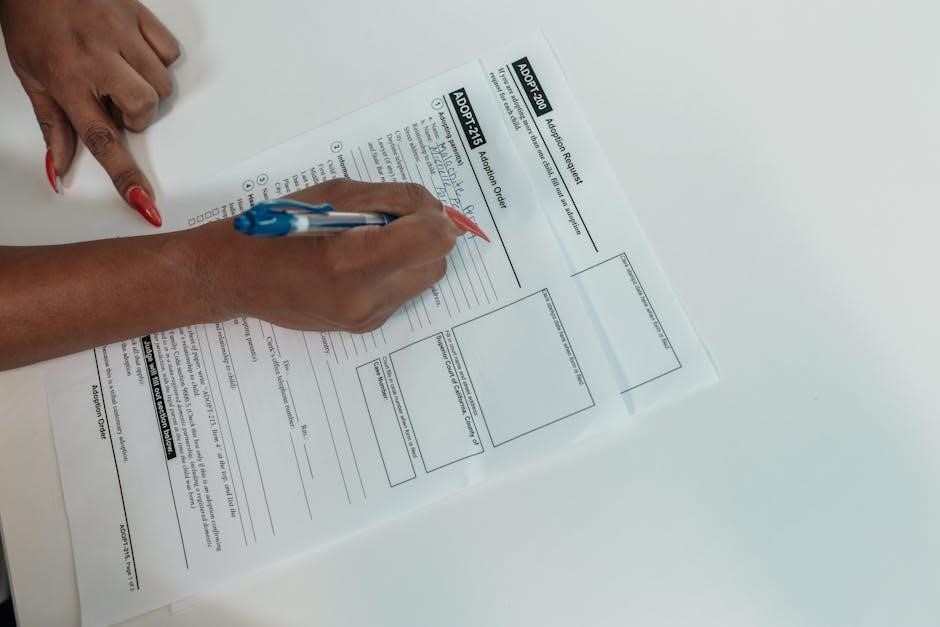Form 410 is a standardized rental application used in Ontario to streamline the tenant screening process. It is designed for landlords and tenants to ensure transparency and fairness.
The form collects essential personal, employment, and financial information, helping landlords assess potential tenants while complying with Ontario rental laws and regulations.
1.1 What is Form 410?
Form 410 is a standardized rental application form used in Ontario, designed by the Ontario Real Estate Association. It streamlines the tenant screening process, ensuring landlords collect essential information about potential tenants efficiently and fairly.
The form is widely recognized and helps landlords comply with Ontario rental laws while maintaining transparency and fairness in tenant selection.
1.2 Importance of Form 410 in Ontario Rentals
Form 410 is crucial for Ontario rentals as it standardizes the application process, ensuring fairness and transparency for both landlords and tenants. It provides a consistent format for evaluating applicants, reducing potential biases and legal risks.
The form also protects both parties by ensuring all necessary information is disclosed, fostering trust and compliance with Ontario rental laws and regulations.
Key Sections of Form 410
Form 410 includes sections for personal information, rental history, employment details, financial data, and references, ensuring a comprehensive evaluation of potential tenants.
2.1 Personal Information
Form 410 requires applicants to provide personal details such as full name, contact information, and identification documents. This section ensures landlords can verify identity and maintain communication throughout the rental process.
2.2 Rental History
The rental history section of Form 410 requires applicants to list previous landlords, rental addresses, and tenancy dates. This helps landlords assess the applicant’s rental reliability and payment history, ensuring a more informed tenant selection process.
2.3 Employment Information
The employment section of Form 410 requires applicants to provide details about their current and previous employers, job titles, and duration of employment. This helps landlords assess the applicant’s financial stability and ability to pay rent consistently, ensuring a reliable tenant-landlord relationship.
2.4 Financial Information
The financial section of Form 410 requests details about the applicant’s income, savings, and debts. This includes bank account information, credit history, and any additional sources of income. Providing accurate financial data helps landlords evaluate the applicant’s ability to meet rental obligations and maintain a stable tenancy.
2.5 References
Applicants must provide contact information for professional and personal references. This typically includes previous landlords and employers to verify rental history, employment, and character. Ensure references are reliable and informed, as landlords may contact them to assess suitability. Providing accurate and relevant references can significantly strengthen a rental application and improve approval chances.

Required Documents for Submission
Applicants must submit identification, proof of employment, bank statements, and pay stubs. These documents verify income, stability, and financial capacity to rent the property responsibly.
3.1 Identification Documents
Identification documents are crucial for verifying an applicant’s identity and residency. Commonly required documents include a valid government-issued ID, such as a driver’s license or passport.
Proof of address, like a utility bill or bank statement, may also be requested to confirm residency and ensure compliance with rental regulations.
3.2 Proof of Employment
Proof of employment is essential to assess an applicant’s financial stability. Common documents include recent pay stubs, a letter from an employer, or a contract outlining salary details.
Self-employed individuals may need to provide tax returns or financial statements to demonstrate income consistency and reliability for rental obligations.
3.3 Bank Statements
Bank statements are required to verify an applicant’s financial stability and cash flow. They typically cover the past 3-6 months, showing income, savings, and expenditure patterns.
Landlords use these statements to assess the applicant’s ability to pay rent consistently and meet financial obligations without defaulting or delays.
3.4 Rental Application Fee
The rental application fee is a non-refundable charge to process the application. It covers costs like credit checks and background screenings.
This fee is standard practice and ensures landlords can assess the applicant’s credibility and financial stability before approving the rental agreement.

Benefits of Using Form 410
Form 410 simplifies the rental application process, ensuring transparency and fairness for both landlords and tenants. It helps landlords evaluate applicants efficiently while protecting tenant rights.
4.1 For Landlords
Form 410 provides landlords with a standardized tool to evaluate potential tenants fairly and efficiently. It ensures comprehensive applicant screening, including rental history and financial stability, while adhering to Ontario rental laws. This helps landlords make informed decisions and reduces legal risks associated with tenant selection.
4.2 For Tenants
Form 410 ensures transparency and fairness for tenants, providing a standardized process for rental applications. It protects tenants from discrimination and ensures their personal information is handled responsibly. The form also streamlines the application process, reducing delays and making it easier for tenants to apply for rental properties in Ontario;

The Submission Process
The submission process involves filling out Form 410 accurately and gathering required documents. Ensure all sections are complete to avoid delays in processing.
Submit the application to the landlord or property manager, either in person, by mail, or online, depending on their preference. Keep a copy for your records.
5.1 How to Fill Out the Form
To fill out Form 410, carefully read the instructions and provide accurate, complete information. Start with personal details, then move through rental history, employment, and financial sections.
Use black ink to avoid smudging and ensure legibility. Double-check for errors and completeness before submitting to avoid delays in processing.

5.2 Submitting the Application
Once completed, submit Form 410 to the landlord or property manager. Ensure all required documents and fees are included to avoid processing delays.
Submit in person, via email, or through an online portal if available. Keep a copy for your records and follow up if you haven’t received confirmation within a few days.
5.3 Follow-Up
After submitting Form 410, wait 2-3 business days before following up. Politely contact the landlord or property manager via phone or email to inquire about the status of your application.
Keep the tone professional and concise, demonstrating your interest in the rental property without appearing pushy. This helps maintain a positive impression and shows responsibility.

Legal Considerations
Form 410 must comply with Ontario rental laws, ensuring non-discrimination and tenant rights. Landlords must avoid illegal questions and follow fair housing practices strictly.
6.1 Ontario Rental Laws
Ontario rental laws govern the use of Form 410, ensuring compliance with the Residential Tenancies Act. The form must not violate tenant rights or include discriminatory questions, aligning with fair housing practices and legal standards for rental applications in the province.
6.2 Discrimination Protections
Form 410 must comply with Ontario’s anti-discrimination laws, ensuring landlords do not unfairly reject applicants based on race, gender, age, disability, or other protected grounds. This ensures equal housing opportunities and aligns with human rights codes, promoting fairness and transparency in the rental process.

Common Mistakes to Avoid
Common mistakes include incomplete information, inaccurate data, and missed deadlines. These errors can delay or disqualify applications, highlighting the importance of careful preparation and attention to detail.
Applicants must ensure all sections are filled accurately and submitted on time to avoid complications in the rental process.
7.1 Incomplete Information
Incomplete information is a common mistake that can delay or disqualify applications. Missing details, such as employment history or rental references, may lead to processing delays or denial of tenancy.
Applicants must ensure all sections are thoroughly filled out, as incomplete data can raise concerns about reliability or transparency, impacting the landlord’s decision-making process.
7.2 Inaccurate Data
Inaccurate data on Form 410 can lead to processing delays or outright denial of the rental application. Providing false or misleading information may result in legal consequences and damage to the applicant’s credibility.
Tenants must ensure all details, such as employment history, income, and rental references, are accurate and truthful to avoid complications during the screening process.
7.3 Missed Deadlines
Missing deadlines for submitting Form 410 can delay processing and reduce chances of securing a rental property. Tenants should prioritize timely submissions to avoid losing competitive opportunities in Ontario’s dynamic housing market.
Applicants must stay proactive, organize documents, and submit applications well before deadlines to ensure their forms are reviewed promptly and fairly by landlords.

How to Fill Out Form 410 Properly
Ensure all sections of Form 410 are completed accurately and thoroughly. Review the form for errors before submission to avoid delays in processing.
8.1 Step-by-Step Guide
Start by filling in your personal information, including name, contact details, and current address. Next, provide rental history with previous landlords’ details. Then, outline employment information, including job title and income. After that, disclose financial details such as bank statements and credit score. Finally, list professional references and review the form for accuracy before signing and submitting it.
8.2 Tips for Accuracy
Double-check all personal and financial details for correctness. Ensure dates are accurate and employment information is up-to-date. Provide honest answers to avoid discrepancies. Attach required documents like pay stubs and bank statements. Review the form thoroughly before submission to avoid errors. Ensure all sections are completed to prevent delays in processing.

Availability and Access
Form 410 is readily available online through the Ontario government website and real estate associations. Tenants can download and print it for submission.
9.1 Where to Get Form 410
Form 410 is available on the Ontario government website and through real estate associations. Tenants can download it directly or request a copy from local tenant boards or rental offices.
9.2 Online vs. Paper Application
Form 410 can be accessed online or obtained as a paper copy. The online version offers convenience, faster submission, and reduced environmental impact. Paper applications are still available for those who prefer traditional methods or lack digital access, ensuring accessibility for all applicants.

Best Practices for Tenants
Tenants should be fully prepared with all required documents, ensuring accuracy and completeness. Organizing information in advance and maintaining professionalism throughout the process enhances the likelihood of a successful application.
10.1 Being Prepared
Tenants should gather all necessary documents beforehand, ensuring they are up-to-date and organized. This includes identification, proof of employment, bank statements, and rental history. Being prepared saves time and demonstrates responsibility, increasing the chances of a successful application. It also helps tenants present themselves as reliable candidates to potential landlords.
10.2 Organizing Documents
Organizing documents is crucial for a smooth application process. Tenants should keep copies of identification, pay stubs, bank statements, and rental history in a dedicated folder. Including reference letters and proof of employment ensures all required information is easily accessible. A well-organized application demonstrates professionalism and efficiency, making it easier for landlords to review.
10.3 Professionalism
Maintaining professionalism is key when completing Form 410. Ensure all information is accurate and presented clearly. Dress appropriately when meeting landlords and communicate respectfully. Following up politely after submission demonstrates responsibility. Professionalism builds trust, increasing the likelihood of a successful rental application and a positive landlord-tenant relationship.
Form 410 simplifies Ontario’s rental process, ensuring fairness and transparency for both landlords and tenants. Properly completing it is crucial for a successful application.
11.1 Summary of Key Points
Form 410 is a standardized rental application in Ontario, ensuring a fair and transparent tenant screening process. It collects essential personal, employment, and financial details, aiding landlords in evaluating potential tenants. Compliance with Ontario rental laws and regulations is maintained, protecting both parties. Proper completion is vital for a successful rental application.
11.2 Final Tips for Success
To ensure a successful rental application, carefully review Form 410 for accuracy and completeness. Submit all required documents promptly and maintain open communication with landlords. Be prepared, organized, and professional throughout the process. Double-check for errors and ensure financial details are up-to-date. Following these steps will enhance your chances of securing your desired rental property.



